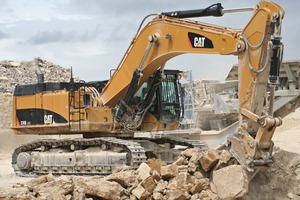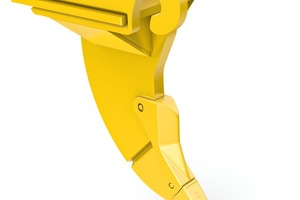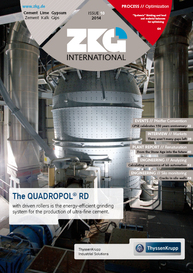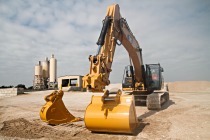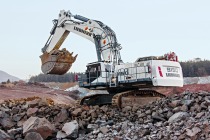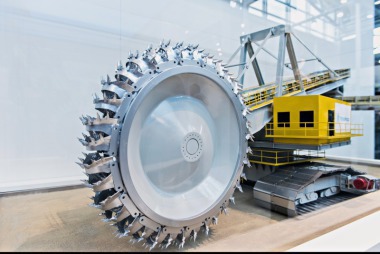Rip and load – an alternative to blasting
Restrictions on the use of explosives in mines and quarries are increasing throughout the world.
In some circumstances, dependent mainly on rock hardness and stratification, ripping with track-type tractors or hydraulic excavators (Fig. 1) can replace blasting or complement reduced blasting. Single shank rippers can be attached (Fig. 2) to track type tractors (> 35 t) and to hydraulic excavators (> 30 t).
Hydraulic excavator ripping is recommended for quarry application. Hydraulic excavators are able to work in restricted areas and on benches and can better exploit rock cracks and discontinuities than track-type tractors Rippers can also be attached to hydraulic excavators using a quick coupler which allows the operator to switch from ripper to bucket (> 30 secs). This allows the hydraulic excavators to both extract the rock and to load the hauling unit.
Ripping is a version of continuous mining. Rock is extracted at the rate of production required by the crusher. When using Rip and Load method, the hydraulic excavator rips a certain quantity of rock and then loads this in order to clear the ground for the next ripping section.
The arguments supporting Rip and Load fall into three main categories:
Environmental – In some cases, the quarry is threatened with closure due to noise, vibrations and dust typically associated with blasting. Infrastructure in the form of neighbouring habitations or industries and even the quarry installations, result in restrictions to blasting. In many countries, the use of explosives is restricted or controlled due to safety or security concerns. In all such cases, areas that can no longer be blasted may be candidates for ripping.
Rock quality improvement – Blasting may result in damage to rock mechanical properties. Ripping can result in higher quality product with fewer cracks and fines*. Aggregates producers may be able to sell rock at higher prices due to lower internal damage. Ripping exposes smaller quantities of rock to the elements with potential impact on processable rock ratios.
Improved quarry margins – Blasting brings high fixed and variable costs. The process is disruptive and time consuming. Where Rip and Load replaces blasting entirely, the benefits to quarry margins can be significant. In cases where ripping is complementary to reduced blasting, there can also be advantages from lower fines* produced with less screening and processing.
There is no ideal formula to determine if ripping at the required rates of production for the quarry is possible. Parameters such as Megapascal compressive strength can be used as indicators for “rippability”. However most rock types exhibit a broad range of values and consequently no definitive scale of rippability can be determined.
Rock type – Sedimentary rocks are usually the most easily ripped due to their bedding characteristics. Metamorphic rocks exhibit a wide range of rippability depending on layering, and igneous rocks such as basalt are the most difficult to rip because they generally lack the stratification needed to rip hard rock.
Rock structure and fabric – Discontinuities in the form of faults, cracks, joints and bedding all produce planes of weakness that can facilitate ripping.
In most cases, a process of field assessment is followed. This involves review by a ripping technician to gather and assess data on the rock deposit. This is complemented with any information from previous experiments with ripping, a physical examination of the quarry and customer visits to sites with similar geology. In cases where an acceptable ripping production forecast results this will lead to an assessment for a field test using an on-site hydraulic excavator or a rented unit which in both cases will be equipped with a ripper either in pin-on or quick coupler configuration.
In rock conditions where ripping cannot reach adequate production rates per hour combining ripping with partial blasting may be the answer. This has a number of advantages:
Any level of rock hardness can be accommodated. As the rock deposit changes, blasting levels can be increased or decreased.
Partial blasting potentially reduces drilling and explosives costs.
Partial blasting usually reduces vibrations, dust, and environmental impact.
Partial blasting can be used in very specific parts of the quarry with the hardest rock. Only those parts of the quarry that are not rippable need be partial blasted.
It is the operator’s responsibility to maintain hourly production for the crusher. Excavator ripping requires specific machine operator knowledge of the ripping method and also experience of site set-up, bench creation, managing the work tools for ripping. For Rip and Load, only 50% of the actual production hour is available for ripping. For the remaining time the operator must sort the rock for loading, keep the area clean and load the incoming trucks.
Hydraulic excavator ripping is most effective from a bench of stick and ripper shank height. The stick cylinder continually engages the ripper into the rock face and ‘works’ the cracks and weaknesses. The boom cylinders provide the productive power as they pull the boom/stick/ripper up through the rock.
The opportunities to employ hydraulic excavator ripping in quarries are quite specific. The motivation to use ripping comes primarily from environmental factors although rock quality and cost of production can also influence quarry owners to question whether this alternative to blasting should be considered.
//www.caterpillar.com" target="_blank" >www.caterpillar.com:www.caterpillar.com

